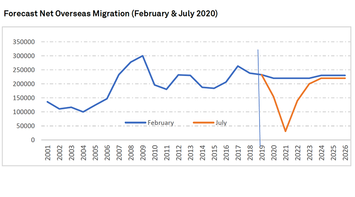
Rarely has the question of where, why and how people will live, work and play been so important, as the impact of COVID-19 begins to transform the demand and supply equation across the Australian property market.
As to whether the impact of the virus and the many variables associated with it will bring forward market trends already underway, or create long-term structural change, is far from being understood. And while rampant speculation on the future of the city will likely continue, one certainty arising from the pandemic is the extent to which the very significant reduction in net overseas migration will impact the number of dwellings required.
Consistently exceeding 200,000 people per annum, net overseas migration in Australia has been a powerful force that has generated significant demand for residential property for over a decade.
Before the onset of COVID-19, overseas migration was to be a major driver of demand, particularly in Sydney and Melbourne, where the combined need for an annual requirement of approximately 100,000 dwellings, was forecast. The Federal Government’s revised overseas migration figure for FY 2021 is 31,000, the lowest in almost 30 years. As a result, underlying demand will fall below 30,000 dwellings in each of Sydney and Melbourne for the first time in many years.
Underpinned by regional inflows and attracting far fewer overseas migrants than its southern counterparts, Brisbane will experience a less dramatic decrease in underlying demand, forecast to require almost 20,000 dwellings over the coming year.
Read or download the full report
Rob Burgess is National Director of Research and Strategy for Charter Keck Cramer.












